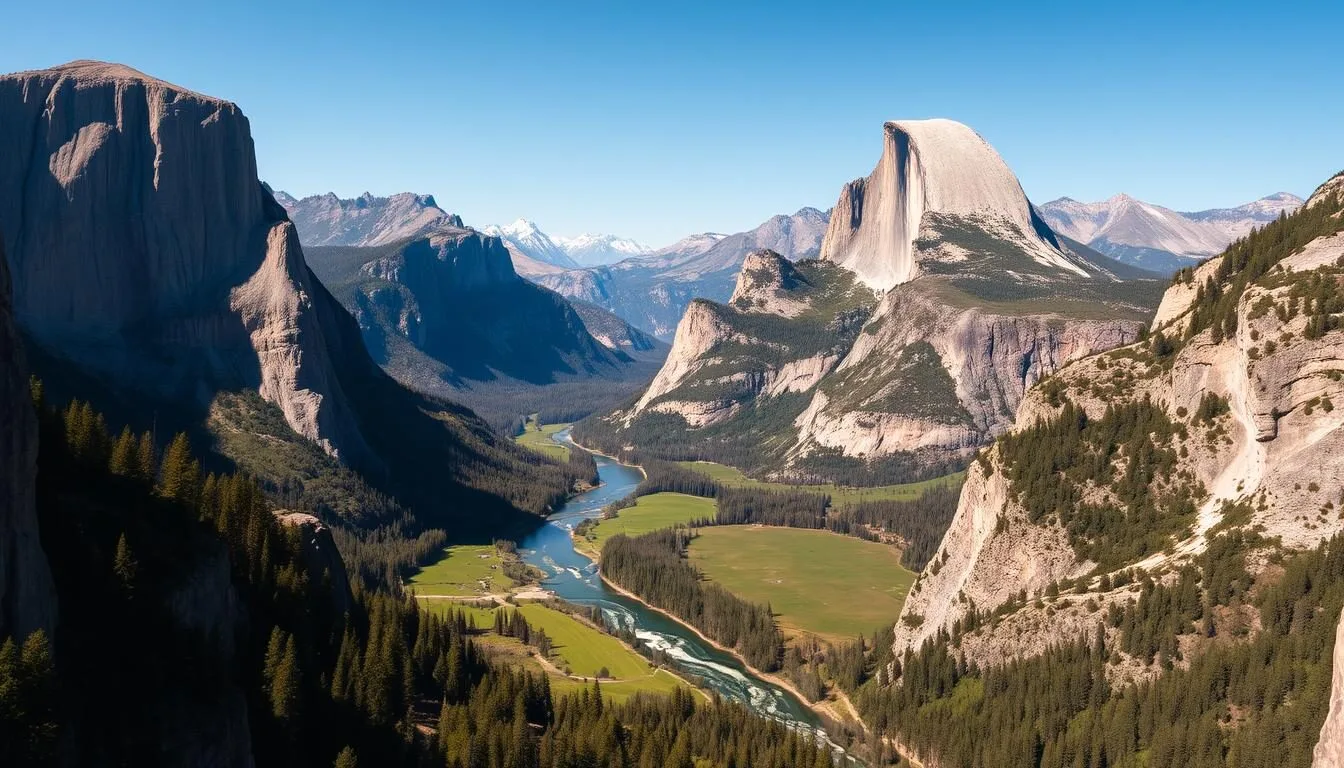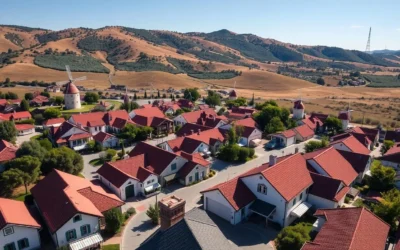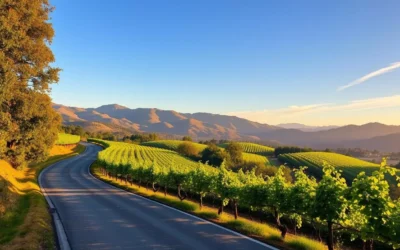Imagine standing at the edge of a valley surrounded by towering granite cliffs and majestic waterfalls. Yosemite National Park is a nature lover’s paradise, attracting millions of visitors each year. As you step into this breathtaking landscape, the sheer scale of its natural beauty leaves you in awe.
With its diverse regions, including Yosemite Valley and Half Dome, the park offers a wide range of experiences. Whether you’re hiking, sightseeing, or simply taking in the views, Yosemite has something for everyone. This guide will help you navigate the top attractions and activities, ensuring you make the most of your visit to this incredible destination.
Discovering the Majesty of Yosemite National Park
As you step into Yosemite National Park, you’re not just entering a scenic wonderland; you’re stepping into a rich tapestry of history and natural beauty that has been millions of years in the making. This park, located in California’s Sierra Nevada Mountains, has been a place of wonder for thousands of years, starting with Native American tribes like the Ahwahneechee.
A Brief History of Yosemite
Yosemite’s history is as fascinating as it is rich. The area was first inhabited by Native American tribes, who considered this valley home long before European settlers arrived. The park was established in 1890, becoming the third national park in the United States, largely thanks to the conservation efforts of John Muir and his famous 1903 camping trip with President Theodore Roosevelt. This trip not only led to further federal protection of Yosemite but also inspired Roosevelt to create additional National Parks and Monuments.
| Year | Event | Significance |
|---|---|---|
| 1890 | Establishment of Yosemite National Park | Third national park in the U.S. |
| 1903 | Camping trip of John Muir and President Theodore Roosevelt | Led to further federal protection and creation of more national parks |
The Diverse Landscapes of Yosemite
Yosemite National Park is renowned for its diverse landscapes, which include towering granite cliffs, lush meadows, ancient sequoia groves, and alpine wilderness. These landscapes span across its 1,200 square miles of protected land, offering a wide range of ecosystems that support a variety of flora and fauna. The park’s diverse landscapes are a major draw for visitors, who come to marvel at the natural beauty and experience the great outdoors.
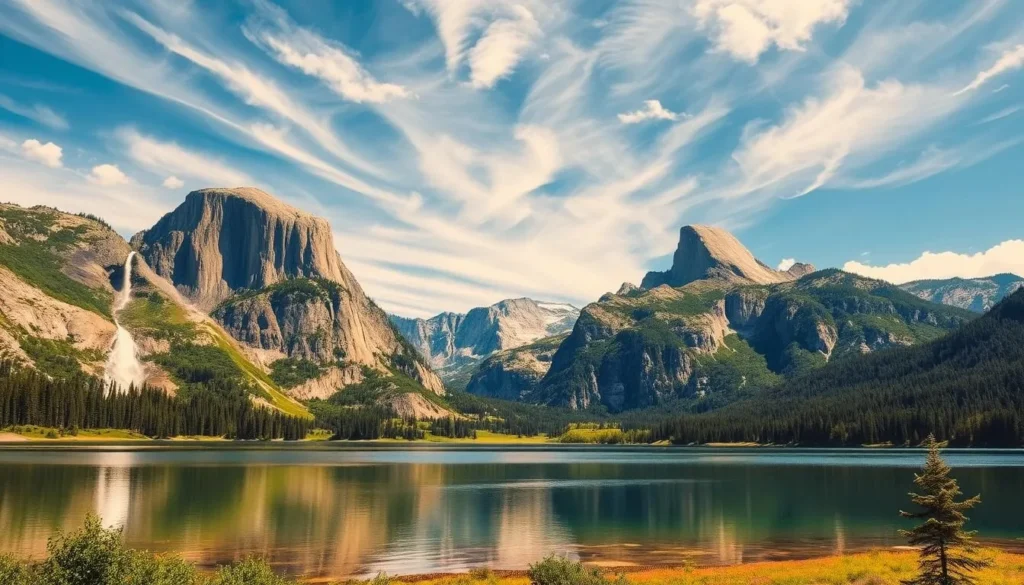
The Five Major Areas of the Park
The park is divided into five major areas: Yosemite Valley, Glacier Point, Wawona and Mariposa Grove, Hetch Hetchy, and Tioga Road/Tuolumne Meadows. Each region offers distinct experiences and perspectives of the park, from the iconic valley views to the high country wilderness. Whether you’re interested in hiking, sightseeing, or simply enjoying nature, Yosemite has something to offer.
Yosemite Valley is the most visited area, known for its stunning granite cliffs and picturesque meadows. Glacier Point offers breathtaking views of Yosemite Valley and the high country. Wawona and Mariposa Grove are home to some of the world’s oldest and largest trees, the giant sequoias. Hetch Hetchy is a lesser-known area with its own unique beauty, and Tioga Road/Tuolumne Meadows offers access to the high country and its many hiking trails.
Planning Your Visit to Yosemite National Park
To make the most of your visit to Yosemite, it’s essential to plan ahead, considering the park’s seasonal variations and requirements. Yosemite National Park is a year-round destination, offering unique experiences in every season.
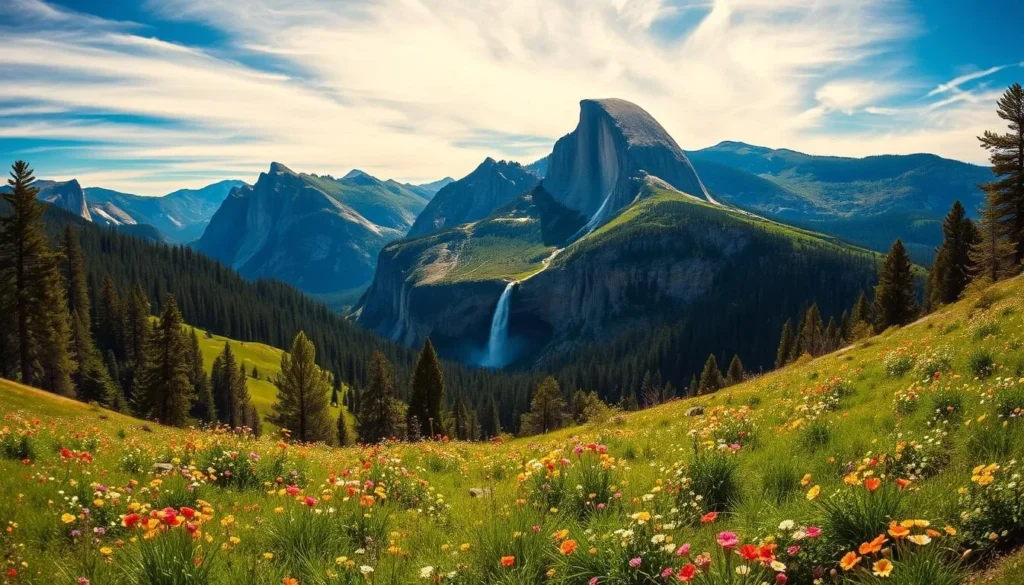
When to Visit Yosemite
The best time to visit Yosemite National Park depends on your preferences and what you want to experience. Each season has its pros and cons. Summer brings the best weather and full access to all areas, including high country roads like Tioga Road, but it’s also the peak tourist season.
Spring is a beautiful time with waterfalls at their peak flow and wildflowers blooming, though some high-elevation areas may still be closed due to snow. Fall offers pleasant weather and fewer crowds, making it an ideal time for those who prefer a more serene experience. Winter transforms Yosemite Valley into a snow-covered wonderland, with dramatically fewer visitors, but many roads and trails are closed.
Reservation Requirements and Entrance Fees
During peak periods, typically summer weekends and holidays, visitors are required to have a reservation to enter the park. It’s crucial to plan ahead and book your reservation in advance to ensure a smooth visit. Additionally, be aware of the entrance fees and any specific regulations that may apply during your visit.
Understanding the reservation requirements and entrance fees will help you experience Yosemite without any unexpected hassles.
How Many Days to Spend in Yosemite
The ideal duration for a visit to Yosemite National Park can vary based on your interests and the activities you have planned. Most visitors find that 3-5 days is sufficient to explore the park’s highlights, though you could easily spend weeks discovering all that Yosemite has to offer.
Whether you’re looking to hike, bike, or simply take in the breathtaking views, planning your days according to your interests will ensure a memorable visit to Yosemite.
Iconic Viewpoints in Yosemite You Can’t Miss
You’re in for a treat as you visit Yosemite’s most iconic viewpoints, each offering a unique perspective on the park’s natural beauty. Yosemite Valley is home to numerous viewpoints that showcase the park’s majestic landscapes, from towering granite cliffs to serene river vistas.
![]()
Tunnel View: The Classic Yosemite Panorama
Tunnel View is one of the most iconic viewpoints in Yosemite, offering a quintessential panorama that has graced countless postcards and photographs. As you pull over at this incredible overlook, you’ll be treated to your first dramatic glimpse of El Capitan, Half Dome, and Bridalveil Fall all in one frame. The viewpoint is particularly stunning at sunrise and sunset, with the golden light casting a warm glow on the granite formations. Visit during the golden hour for the best photography opportunities.
Glacier Point: Half Dome Up Close
Perched 3,214 feet above the valley floor, Glacier Point delivers perhaps the most spectacular view in the entire park. You’ll feel as though Half Dome is within arm’s reach, with panoramic vistas of the High Sierra stretching out beyond. The viewpoint is a must-visit, especially during sunset when the sky is painted with hues of orange and pink. The sheer scale of the landscape will leave you breathless.
Valley View: Riverside Perspectives
For a more intimate perspective, head to Valley View, where the Merced River flows gently in the foreground and El Capitan towers above. This viewpoint is perfect for reflection photography, with the calm waters of the river providing a serene mirror image of the surrounding landscape. Take a moment to appreciate the tranquility of the valley floor, surrounded by the majestic granite cliffs.
Sentinel Bridge and Swinging Bridge
Sentinel Bridge offers one of the most photographed views in Yosemite, with Half Dome perfectly framed and reflected in the calm waters of the Merced River below. Meanwhile, Swinging Bridge (which doesn’t actually swing anymore) provides wonderful views of Yosemite Falls and access to a peaceful stretch of the Merced River where you can dip your toes on hot summer days. Both viewpoints are a great spot to relax and take in the natural beauty of the park.
| Viewpoint | Best Time to Visit | Notable Features |
|---|---|---|
| Tunnel View | Sunrise, Sunset | El Capitan, Half Dome, Bridalveil Fall |
| Glacier Point | Sunset | Half Dome, High Sierra vistas |
| Valley View | Anytime | Merced River, El Capitan |
| Sentinel Bridge | Anytime | Half Dome, Merced River reflection |
| Swinging Bridge | Summer | Yosemite Falls, Merced River access |
As you explore these iconic viewpoints, remember to take your time and appreciate the natural beauty that surrounds you. Whether you’re a photographer, nature lover, or simply looking to experience the best of Yosemite, these viewpoints are sure to leave a lasting impression.
Yosemite National Park, California: Best Things to Do – Top Picks in Yosemite Valley
The heart of Yosemite National Park, Yosemite Valley, is a treasure trove of exciting experiences and unforgettable landscapes. As you explore this iconic valley, you’ll discover a range of activities that cater to all ages and interests.
Exploring the Valley Floor Loop
One of the best ways to experience the beauty of Yosemite Valley is by driving the Valley Floor Loop, a 13-mile scenic drive that showcases the valley’s most iconic landmarks, including El Capitan, Yosemite Falls, and Half Dome. This leisurely drive allows you to take in the stunning views without needing to hike extensively.
Biking Through Yosemite Valley
Biking is another fantastic way to explore Yosemite Valley, with over 12 miles of paved bike paths that connect major attractions while avoiding traffic congestion. You can rent bikes or use the free bike share program for rides under 2 hours, making it easy to enjoy the valley’s scenic beauty at your own pace.
Visiting the Yosemite Museum and Ansel Adams Gallery
The Yosemite Museum and Ansel Adams Gallery are must-visit attractions in Yosemite Village. The museum, established in 1926, provides insights into the history and culture of the Ahwahnee people, while the gallery showcases the iconic black-and-white photographs of Ansel Adams, which have helped define Yosemite’s image in the public imagination.
Swimming and Relaxing at Cathedral Beach
During the hot summer months, Cathedral Beach on the Merced River is a favorite spot for swimming, paddleboarding, and sunbathing. With El Capitan towering above, you can relax on the beach or take a refreshing dip in the river, making it an ideal spot to unwind and enjoy the natural beauty of Yosemite Valley.
| Activity | Location | Description |
|---|---|---|
| Valley Floor Loop | Yosemite Valley | A 13-mile scenic drive showcasing iconic landmarks like El Capitan and Half Dome. |
| Biking | Yosemite Valley | Over 12 miles of paved bike paths connecting major attractions. |
| Yosemite Museum | Yosemite Village | Provides insights into the history and culture of the Ahwahnee people. |
| Cathedral Beach | Merced River, Yosemite Valley | A popular spot for swimming, paddleboarding, and sunbathing. |
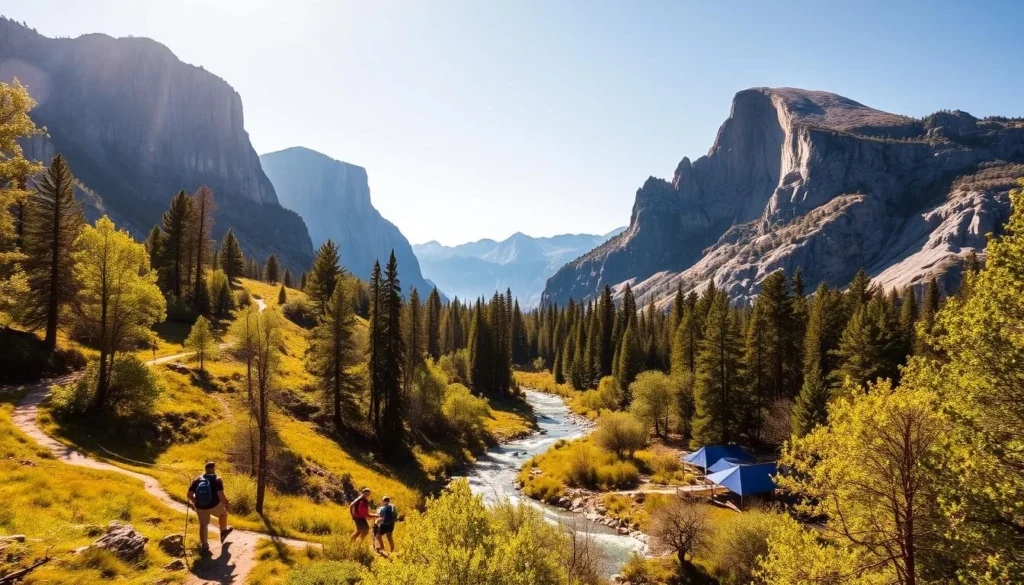
Must-See Waterfalls in Yosemite Valley
Yosemite Valley is renowned for its breathtaking waterfalls, a true marvel of nature. As you explore the valley, you’ll encounter some of the most spectacular waterfalls in the world, each with its unique charm and character.
Yosemite Falls: North America’s Tallest Waterfall
Yosemite Falls is one of the largest waterfalls in North America, standing at an impressive 2,425 feet. The paved Lower Yosemite Falls Trail takes you to a viewpoint of the lower falls, which drop 320 feet, a truly awe-inspiring sight. During peak season, the water is raging, and you’ll get a nice misting as you walk across the trail. The best time to visit Yosemite Falls is during spring snowmelt, from April to June, when the waterfall is at its peak flow.
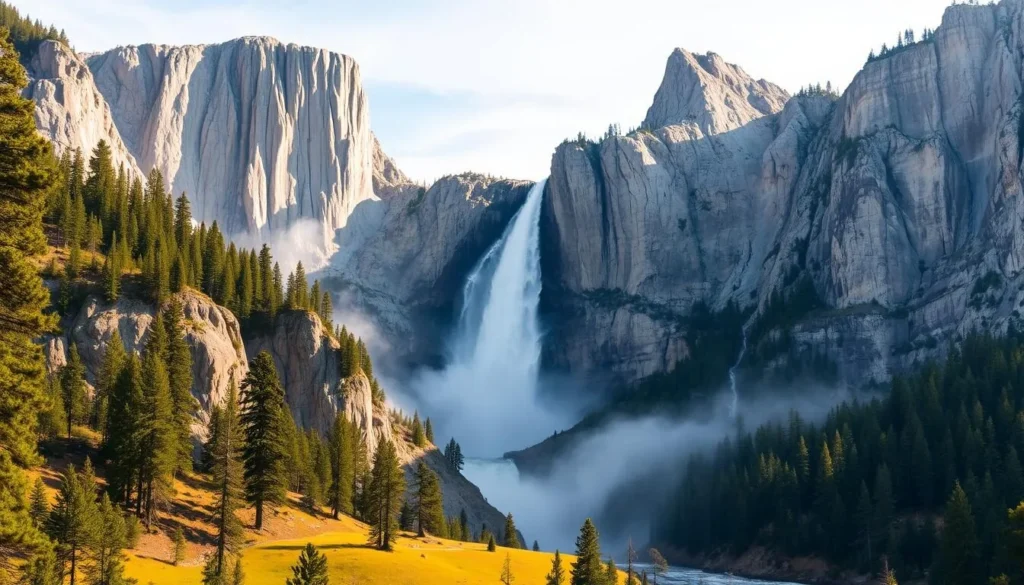
Bridalveil Fall: The Welcoming Waterfall
Bridalveil Fall is another iconic waterfall in Yosemite Valley, welcoming visitors with its delicate 620-foot cascade. The fall sways gently in the breeze, giving it a romantic appearance. You can enjoy the view of Bridalveil Fall from various viewpoints along the valley floor. The gentle sway of the fall in the wind adds to its ethereal beauty.
Vernal and Nevada Falls: The Mist Trail Duo
The Mist Trail to Vernal and Nevada Falls is one of the top hiking experiences in Yosemite National Park. This challenging trail takes you to the top of both Vernal and Nevada Falls, offering breathtaking views and an exhilarating experience. Vernal Fall drops 317 feet, while Nevada Fall plunges 594 feet, creating a spectacular one-two punch of waterfall viewing on a single trail. Be prepared to get soaked by the mist from the falls, adding to the excitement of the hike.
| Waterfall | Height (feet) | Best Time to Visit |
|---|---|---|
| Yosemite Falls | 2,425 | April-June |
| Bridalveil Fall | 620 | Year-round |
| Vernal Fall | 317 | April-June |
| Nevada Fall | 594 | April-June |
Yosemite’s waterfalls are seasonal and dependent on snowmelt, reaching their peak flow in late spring and early summer. By late August, many of the waterfalls are reduced to a trickle or completely dry. Planning your visit during the peak season will ensure that you witness the waterfalls at their most spectacular.
Best Day Hikes in Yosemite Valley
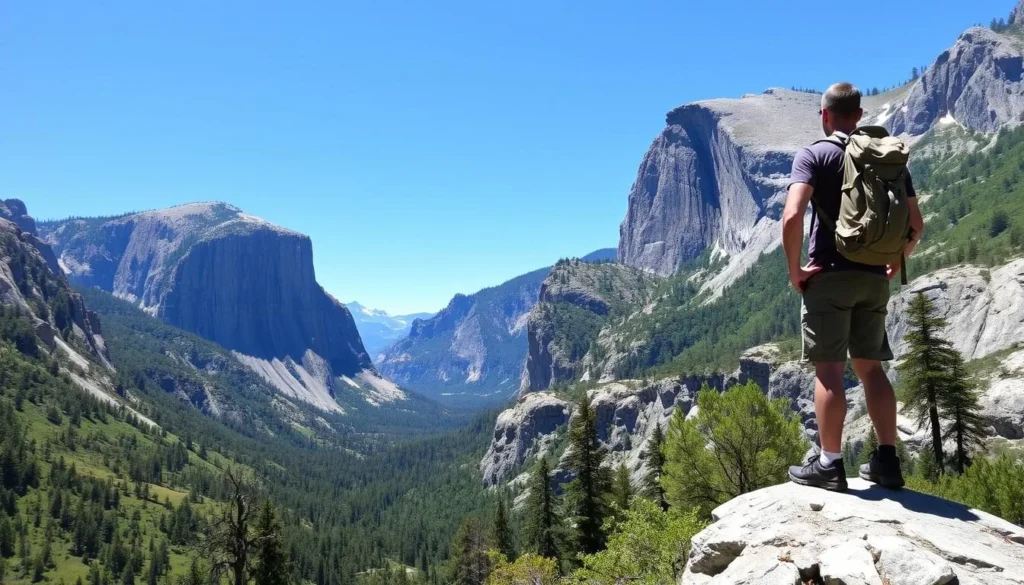
For those looking to experience the best of Yosemite Valley, several day hikes stand out for their scenic views and accessibility. Yosemite National Park offers a variety of trails that cater to different skill levels and interests, ensuring that every visitor can enjoy the natural beauty of the valley.
Lower Yosemite Falls Trail: Easy and Rewarding
The Lower Yosemite Falls Trail is an accessible 1.2-mile round trip hike on a paved path, perfect for families and those with limited mobility. It delivers spectacular views of the lower cascade of North America’s tallest waterfall, making it a great introduction to Yosemite’s natural wonders.
Mirror Lake Trail: Reflections of Half Dome
Mirror Lake Trail provides a moderate 2-5 mile hike to a seasonal lake that perfectly reflects Half Dome when water levels are right. This trail is especially beautiful in spring and early summer, offering a serene and picturesque experience.
Cook’s Meadow Loop: Valley Views for All Ages
Cook’s Meadow Loop is a flat, easy 2-mile loop through lush meadows with 360-degree views of Yosemite’s greatest hits: Half Dome, Glacier Point, Sentinel Rock, and Yosemite Falls. This trail is suitable for all ages and provides a relaxing hike with stunning valley views.
Artist Point Trail: A Less Crowded Alternative to Tunnel View
Artist Point Trail offers a less-crowded alternative to the famous Tunnel View, with a short but moderately steep 2-mile round trip hike. It rewards you with an elevated perspective of the same iconic Yosemite Valley panorama, making it a great option for those seeking a more secluded experience.
Bridalveil Fall Trail: Quick and Refreshing
Bridalveil Fall Trail is one of the quickest and most accessible hikes in the park at just 0.8 miles round trip, leading to the base of the 620-foot waterfall. It often creates a misty rainbow effect in the afternoon sun, adding to the trail’s allure.
These day hikes in Yosemite Valley provide excellent options for visitors of all abilities to experience the natural beauty of Yosemite National Park without committing to strenuous all-day adventures. They are perfect additions to any Yosemite itinerary, offering a mix of scenic views, accessibility, and memorable experiences.
Challenging Hikes for Adventure Seekers
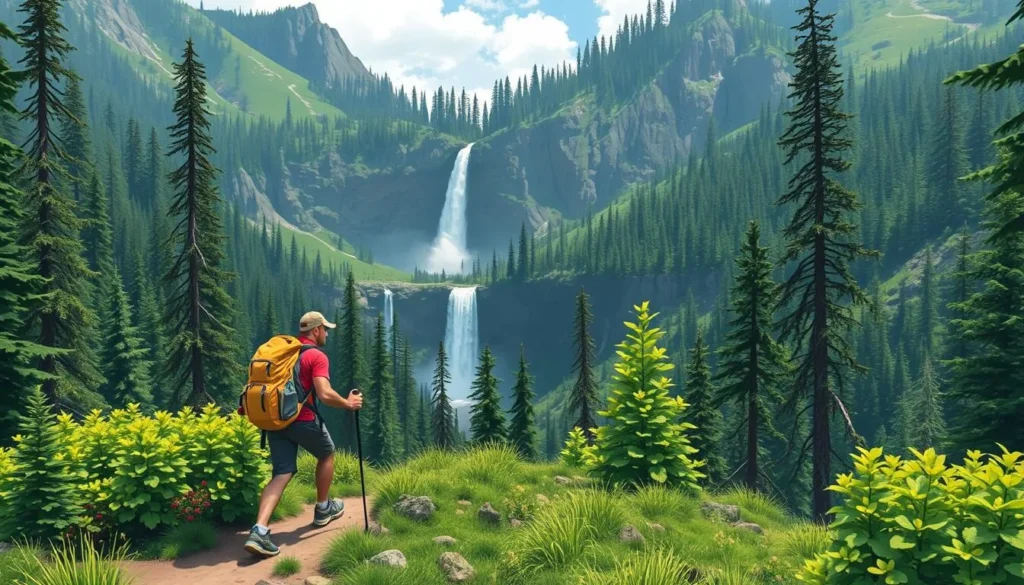
For adventure seekers, Yosemite National Park offers some of the most challenging and rewarding hikes in the world. These trails are not for the faint of heart, but for those who are willing to push their limits, the rewards are well worth the effort.
The Mist Trail to Vernal and Nevada Falls
The Mist Trail to Vernal and Nevada Falls is a 6.4-mile round-trip hike that takes you up close to two magnificent waterfalls. You’ll climb steep granite staircases while being drenched by refreshing mist, making for a thrilling and invigorating experience.
Upper Yosemite Falls Trail: Conquering 2,425 Feet
The Upper Yosemite Falls Trail is a challenging 6.6-mile round-trip climb with over 3,200 feet of elevation gain. The effort is rewarded with spectacular views of North America’s tallest waterfall and panoramic vistas of Yosemite Valley.
Four Mile Trail: Valley to Glacier Point
The Four Mile Trail connects Yosemite Valley with Glacier Point, offering continuously changing perspectives of El Capitan, Yosemite Falls, and Half Dome as you climb nearly 3,500 feet. This 9.7-mile round-trip hike is a must-do for any serious hiker.
Half Dome Trail: The Ultimate Yosemite Challenge
The Half Dome Trail represents the ultimate Yosemite challenge, a 16.5-mile round-trip adventure with 5,300 feet of elevation gain. The famous cable section requires hikers to pull themselves up the steep granite dome using steel cables. It’s a thrilling and unforgettable experience.
Image of Half Dome Trail
These challenging hikes require proper preparation, including early starts, plenty of water, appropriate footwear, and in the case of Half Dome, a permit secured through a competitive lottery system. While demanding, these trails offer some of the most rewarding experiences in Yosemite, with views and accomplishments that will stay with you long after your visit.
Exploring Glacier Point Road
If you’re looking for the best views in Yosemite, Glacier Point Road is the place to be, with its stunning vistas and panoramic views. This scenic drive provides access to some of the park’s most spectacular viewpoints, although it’s typically only open from late May through October or November, depending on snow conditions.
Glacier Point: The Premier Viewpoint
Glacier Point offers what many consider the ultimate Yosemite vista, with Half Dome front and center, Nevada and Vernal Falls visible below, and the High Sierra stretching into the distance. It’s a view that’s sure to leave you breathless, and it’s no wonder that it’s one of the most photographed spots in the park.
Washburn Point: The Less Crowded Alternative
For a slightly different perspective, head to Washburn Point, located just before Glacier Point. This viewpoint provides a better angle on Vernal and Nevada Falls, often with fewer crowds than its more famous neighbor.
Sentinel Dome: 360-Degree Panoramas
For a more immersive experience, take the relatively easy 2.2-mile round-trip hike to Sentinel Dome. The unobstructed 360-degree views from the top are breathtaking, and many consider them even better than Glacier Point because of their panoramic nature.
Taft Point: Cliff-Edge Thrills
If you’re looking for a thrilling experience, head to Taft Point, which offers sheer drop-offs and dramatic fissures in the cliff face. The vertigo-inducing views straight down to Yosemite Valley 3,500 feet below are not for the faint of heart.
These viewpoints are especially magical at sunset when the alpenglow turns Half Dome and the surrounding peaks a glowing pink and orange, making them worth the hour-long drive from Yosemite Valley.
Mariposa Grove: Walking Among Giants
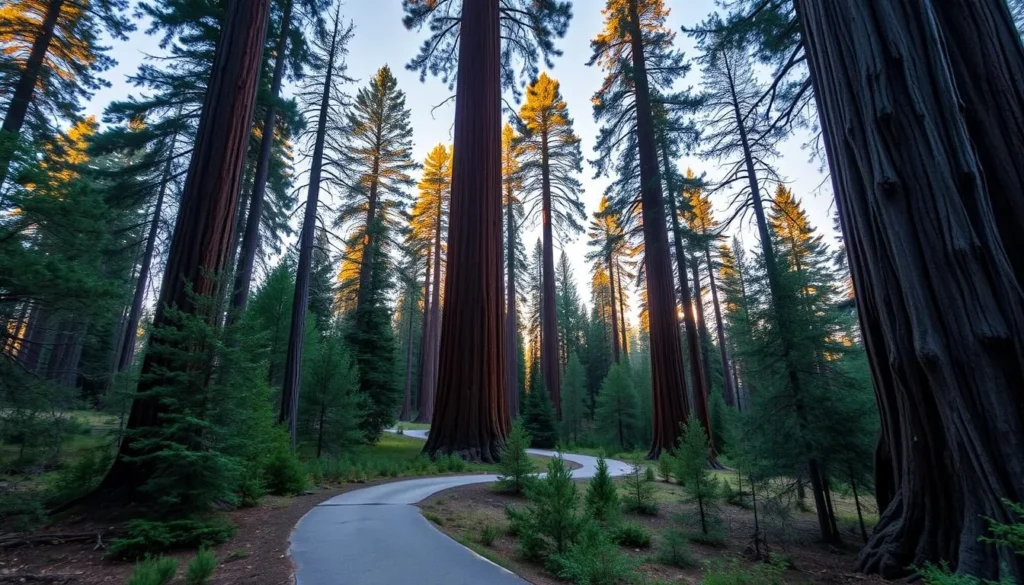
As you step into Mariposa Grove, you’re surrounded by some of the world’s largest and oldest trees, creating an atmosphere of serenity and awe. This beautiful area of Yosemite National Park, located on the west side between Fish Camp and Wawona, is home to over 500 mature giant sequoias. These natural wonders can reach heights of nearly 300 feet and ages exceeding 2,000 years, making them some of the largest and oldest living organisms on Earth.
The Big Trees Loop Trail
The Big Trees Loop Trail offers an accessible 0.3-mile introduction to the magnificent giant sequoias. This short, easy loop is perfect for visitors with limited time or mobility issues, providing a glimpse into the beauty of these natural giants.
Grizzly Giant Loop Trail
The Grizzly Giant Loop Trail, a 2.1-mile round trip, takes you to some of the most famous trees in the grove, including the massive Grizzly Giant. Estimated to be 2,700 years old, this sequoia is one of the oldest in the world, offering a profound experience for hikers.
Famous Trees: Grizzly Giant, Clothespin Tree, and Fallen Monarch
Mariposa Grove is home to many iconic trees, including the Grizzly Giant, the Clothespin Tree with its unique fire scar, and the Fallen Monarch, a massive fallen sequoia you can walk through. These trees are not only natural wonders but also tell the story of the grove’s history and ecology.
Tips for Visiting Mariposa Grove
To make the most of your visit to Mariposa Grove, consider arriving early in the morning or visiting during the shoulder seasons to avoid crowds. Be prepared to take the shuttle from the welcome plaza during peak periods. Understanding that sequoias depend on periodic fires for reproduction can also enhance your appreciation of the grove’s ecology.
Tuolumne Meadows and Tioga Road
Tioga Road offers a breathtaking journey through Yosemite’s high country, providing a unique perspective on the park’s natural beauty. This scenic drive is a must-experience when visiting Yosemite National Park.
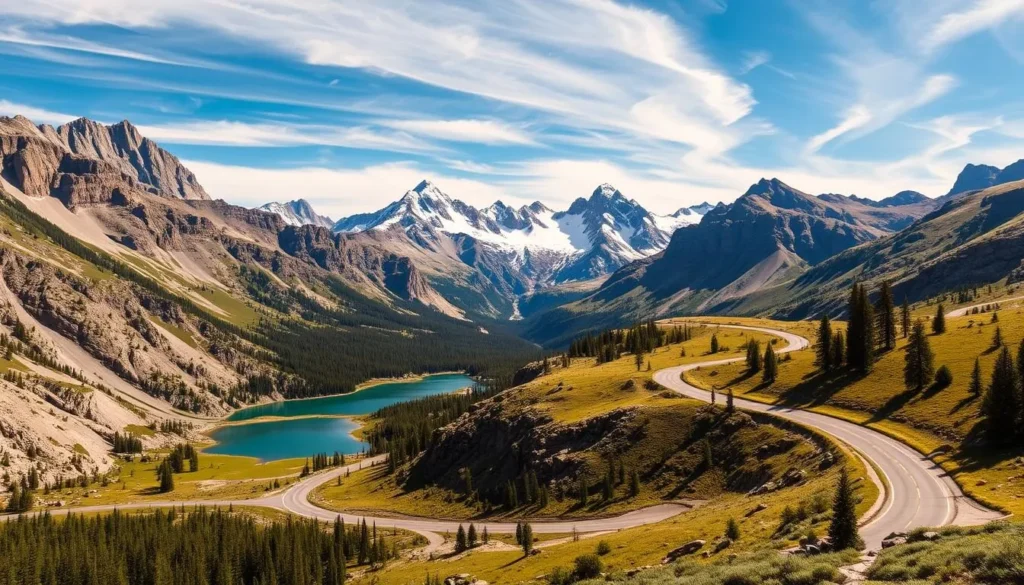
Scenic Drive Along Tioga Road
The 39-mile scenic drive from Crane Flat to Tioga Pass takes you through pristine forests, past granite domes, and alongside crystal-clear lakes. This journey offers a completely different perspective of Yosemite National Park than the valley floor. As you drive along Tioga Road, be sure to stop at Olmsted Point to take in the views.
- Experience one of America’s most spectacular alpine drives.
- Enjoy elevations over 9,000 feet, but note that it’s typically only open from late May or June through October or November.
Tuolumne Meadows: Alpine Beauty
Tuolumne Meadows, at 8,600 feet elevation, is the largest subalpine meadow in the Sierra Nevada. It offers spectacular wildflower displays in July and August, plus numerous hiking trails into the surrounding wilderness. Take a moment to appreciate the serene beauty of this alpine meadow.
Tenaya Lake: The Jewel of the High Country
Tenaya Lake is often called “the jewel of the high country.” It provides one of the most picturesque alpine lake settings in the park, with opportunities for swimming, kayaking, and picnicking along its granite-lined shores. Enjoy the tranquility of this beautiful lake.
Tuolumne Grove Trail: A Hidden Sequoia Grove
The Tuolumne Grove Trail offers a less-crowded alternative to Mariposa Grove, featuring about two dozen mature giant sequoias accessible via a 2.5-mile round trip hike. Explore this hidden gem and experience the majesty of these ancient trees.
As you explore Yosemite National Park via Tioga Road, remember to take your time and appreciate the scenic drives and hiking trails that make this park so special.
Hetch Hetchy: Yosemite’s Hidden Valley
Yosemite’s Hetch Hetchy Valley is a fascinating destination that combines stunning landscapes with a poignant environmental history. Located in the remote northwestern corner of Yosemite National Park, Hetch Hetchy offers a serene escape from the crowds that often flock to Yosemite Valley.
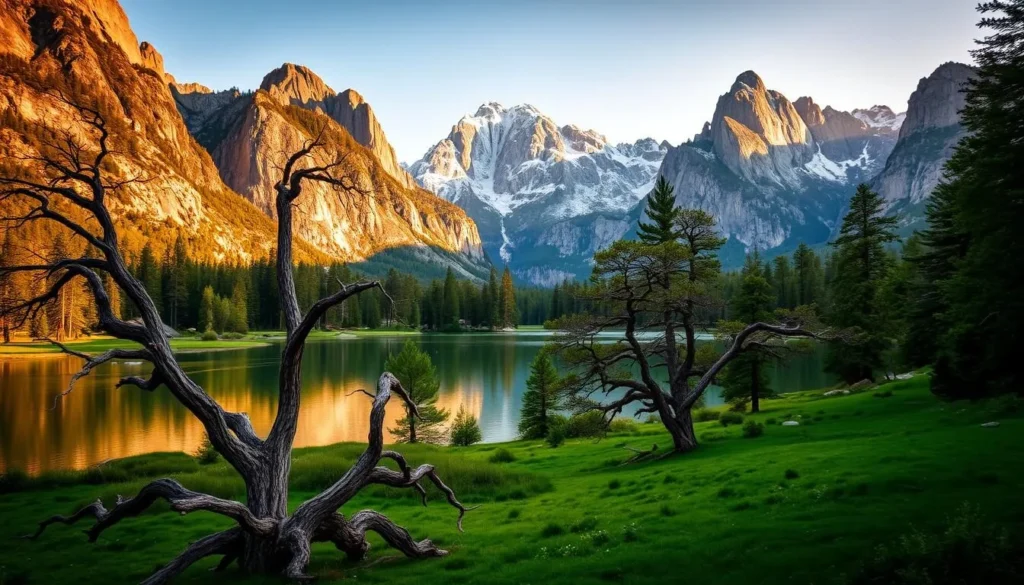
The History of Hetch Hetchy Valley
Hetch Hetchy Valley was once considered Yosemite’s twin valley, with John Muir describing it as “a wonderfully exact counterpart of the Merced Valley” before it was dammed in 1923 to provide water for San Francisco. The controversial flooding of Hetch Hetchy represents one of America’s most significant conservation battles, with John Muir fighting unsuccessfully to save the valley. Today, the Hetch Hetchy Reservoir supplies pristine drinking water to 2.4 million Bay Area residents.
Day Hikes Around Hetch Hetchy
If you’re looking to explore Hetch Hetchy, there are several day hikes that offer breathtaking views and a chance to experience the natural beauty of the area. The Wapama Falls Trail is a 5-mile round trip moderate hike that takes you across the O’Shaughnessy Dam and along the reservoir’s northern shore to the base of the 1,400-foot waterfall. For more ambitious hikers, the Rancheria Falls Trail continues beyond Wapama Falls for a 13-mile round trip adventure to another impressive cascade.
Hetch Hetchy is typically accessible year-round and requires no reservations during peak season, making it an excellent option when other areas of the park are crowded or require advance planning. Whether you’re a nature enthusiast, a hiker, or simply looking for a peaceful retreat, Hetch Hetchy offers a unique and unforgettable experience within Yosemite National Park.
Water Activities in Yosemite
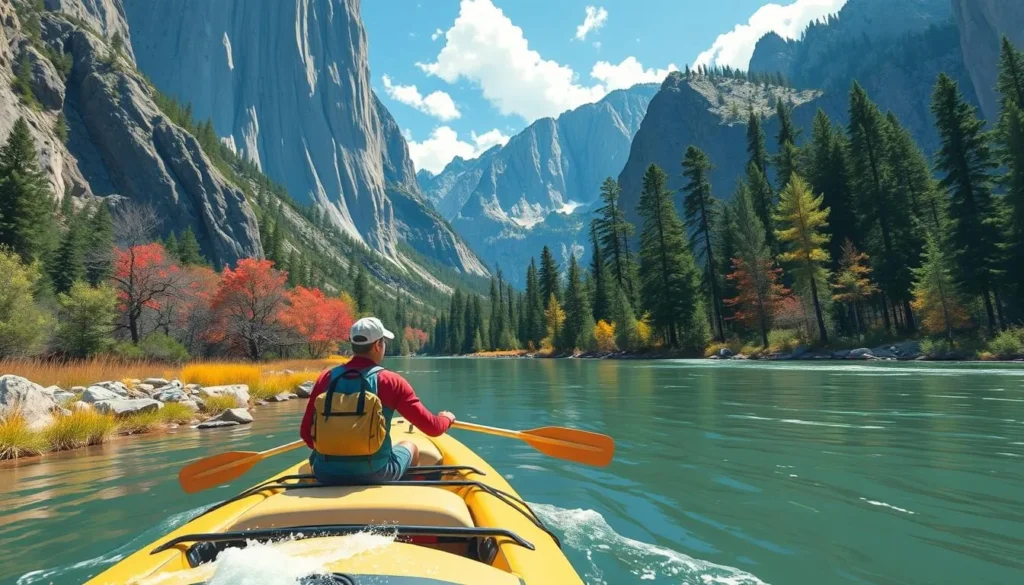
From rafting down the Merced River to kayaking on Tenaya Lake, Yosemite National Park has something for every water enthusiast. The park’s diverse landscapes and water bodies offer a unique opportunity to experience nature from different perspectives.
Rafting the Merced River
Rafting the Merced River is a popular summer activity in Yosemite National Park, offering a refreshing and relaxing way to experience Yosemite Valley from a different perspective. You can rent a raft at Curry Village and put in at Stoneman Bridge (near Curry Village) and take out at Sentinel Beach Picnic Area.
Raft rentals are available during summer months when water levels are appropriate, typically June through July, with the 3-mile float taking about 2-3 hours at a leisurely pace. For those seeking more adventure, guided whitewater rafting trips are available on sections of the Merced River outside the park boundaries, offering Class III and IV rapids during the spring runoff.
Swimming Holes in Yosemite
Yosemite features numerous natural swimming holes where you can cool off during hot summer days. Popular spots include Cathedral Beach, Sentinel Beach, and the calm pools along Tenaya Creek. Always be aware of water conditions, as rivers can be dangerously cold and swift during spring runoff.
Kayaking and SUPing at Tenaya Lake
Tenaya Lake, located along Tioga Road, provides one of the most scenic settings for kayaking and stand-up paddleboarding in the park, with crystal-clear waters surrounded by granite domes. If you have your own kayak or SUP, it’s a relaxing place to get out on the water. If not, Tenaya Lake is still a worthwhile place to stop for a picnic or a swim.
Rock Climbing in the World’s Premier Destination
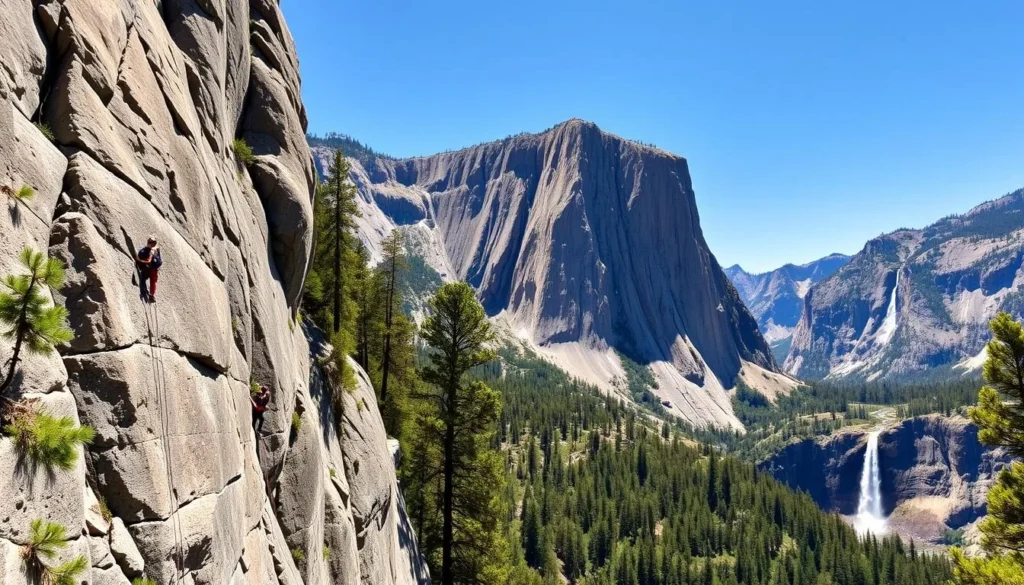
As one of the world’s premier rock climbing destinations, Yosemite National Park attracts climbers from around the globe. The park’s massive granite walls offer a range of climbing routes for all skill levels, from beginners to seasoned experts.
El Capitan: The Big Wall Challenge
El Capitan, rising 3,000 feet from the valley floor, is the ultimate big wall climbing challenge. Routes like The Nose and Free Rider push the boundaries of what’s possible in the sport. Even if you’re not a climber, watching climbers on El Capitan from El Cap Meadow (bring binoculars!) offers a fascinating glimpse into this extreme sport.
Beginner Climbing Lessons with Yosemite Mountaineering School
For beginners wanting to experience Yosemite’s climbing tradition, the Yosemite Mountaineering School offers lessons and guided climbs for all skill levels, providing all necessary equipment. You can learn the basics of rock climbing and enjoy the park’s iconic landscapes with expert guidance.
Yosemite National Park is considered the birthplace of modern rock climbing, with its massive granite walls drawing climbers from around the world. The park offers a variety of climbing experiences, from crack climbing to big wall ascents. Whether you’re a seasoned climber or just starting out, Yosemite has something to offer.
For those interested in exploring more than just climbing, Camp4, the historic climbers’ campground, serves as both accommodation and a living museum of climbing history. You might even spot world-class climbers preparing for their next big adventure.
Historic Sites and Accommodations
Yosemite National Park’s historic sites and accommodations are a testament to its enduring appeal and rich history. As you visit Yosemite Valley, you’ll have the opportunity to experience the park’s heritage firsthand through its iconic hotels, historic landmarks, and cultural sites.
The Ahwahnee Hotel: Luxury in the Wilderness
Open since 1927, The Ahwahnee is the oldest and most historic hotel in Yosemite National Park. Located in a quiet corner of Yosemite Valley, away from the busyness that surrounds Yosemite Village, The Ahwahnee offers an elegant lodge experience beneath the granite cliffs. It’s quite expensive to stay at, but you can still experience the grounds by having coffee, lunch, a light dinner, or a drink at the Ahwahnee Bar. I recommend sitting outside on the patio to enjoy the views of the park while eating.
The Ahwahnee Hotel stands as the crown jewel of national park lodges, combining rustic architecture with elegant accommodations in a stunning setting. Built to attract wealthy and influential visitors who could help support the national park system, The Ahwahnee features a stunning Great Lounge with massive stone fireplaces, Native American artwork, and soaring ceilings. Even if you’re not staying at The Ahwahnee, you can experience its grandeur by enjoying a meal in the magnificent dining room or simply wandering the public spaces.
Camp4: The Birthplace of Modern Rock Climbing
Camp4, listed on the National Register of Historic Places, represents the heart of Yosemite’s climbing culture since the 1950s. Pioneers like Royal Robbins and Warren Harding developed techniques that revolutionized the sport at Camp4. Today, Camp4 continues to be a hub for climbers and adventurers, embodying the spirit of exploration and innovation that defines Yosemite National Park.
In addition to The Ahwahnee and Camp4, other historic sites in Yosemite Valley include the Yosemite Valley Chapel, built in 1879, which is the oldest structure in the valley and continues to host regular services and weddings. The Yosemite Cemetery near Yosemite Village contains the graves of early pioneers, Native Americans, and significant figures in the park’s history, offering a quiet place for reflection on the human stories behind Yosemite’s development.
Beating the Crowds in Yosemite
Beating the crowds in Yosemite requires some planning and insider knowledge. Yosemite National Park is one of the most visited national parks in the US, making it challenging to avoid the crowds. However, with the right strategies, you can experience the park’s natural beauty without the chaos.
Early Morning Strategies
Arriving at popular destinations like Yosemite Valley before 8:00 AM can significantly enhance your experience. You’ll be able to enjoy iconic spots like Tunnel View, Bridalveil Fall, and Lower Yosemite Falls with fewer people around. This early morning tranquility allows for a more peaceful and enjoyable visit.
Off-Season Visits
Visiting Yosemite during the shoulder seasons (April-May or September-October) is an excellent way to avoid the crowds. The weather is pleasant, and you’ll have the opportunity to enjoy special seasonal attractions like peak waterfall flow in spring or fall colors in October. If you’re looking for a more serene experience, consider visiting during the winter months (November-March), but be prepared for winter driving conditions.
Lesser-Known Areas of the Park
Exploring less-visited areas of the park is another effective way to beat the crowds. Consider visiting Tioga Road when it’s open, or head to Hetch Hetchy or Crane Flat. These areas offer spectacular scenery without the concentrated crowds of Yosemite Valley. Additionally, hiking just a mile or two beyond the most popular viewpoints can separate you from 90% of visitors.
Conclusion: Creating Unforgettable Memories in Yosemite
With its unique blend of accessibility and wilderness, Yosemite National Park offers something for every kind of traveler. You can stand beneath 3,000-foot waterfalls, walk among ancient giant sequoias, and gaze up at towering granite monoliths like Half Dome and El Capitan, all within a single day.
The best things to do in Yosemite National Park often involve finding your own personal connection to this special place, whether through photography, hiking, or simply sitting quietly beside the Merced River. As you plan your visit, remember that flexibility, patience, and respect for both nature and fellow visitors will enhance your experience in this extraordinary landscape.
Whether you’re drawn to the iconic views or the peaceful solitude of the high country, Yosemite National Park rewards visitors with experiences that remain vivid in memory long after returning home. You’ll leave with a deeper appreciation for the vision of those who protected this land and a desire to return to discover more of its endless wonders.
